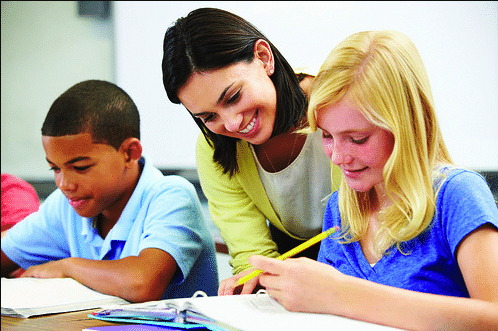From Information to Integrative Thinking
By Mac Bogert
What is success for our schools? 
There was a time when schools provided access to information. They offered textbooks and resources unavailable to many children in their homes. Teachers provided their students with a measured approach to learning skills they might not find otherwise.
Schools also afforded — and still do — a secure place for our children to spend their day. A gentle incarceration, as it were.
Schools offer employment for teachers. I’ve been a teacher most of my life. I have great respect for the profession — long hours; pressure from all sides; frequent barbs from those who’ve never taught (those who can’t, teach); straddling the gap between parent, counselor, life coach, disciplinarian, and the list goes on. Nothing I’m about to propose suggests dispensing with teachers. On the contrary, I’m suggesting a vital and exciting opportunity for teachers.
What our schools don’t seem to be doing is challenging students and releasing them into the world as lifelong, agile learners with full capacity for growth and development. They’re trapped in grade levels, straightjacketed by standardized tests and grades, removed from taking charge of their own learning.
They’re reacting, not initiating, responding rather than leading and originating. As our educational system has grown, it’s been taken down the road of the factory, toward uniformity and away from vitality. And there is no uniform road to that vitality. When our schools focus on standardization, they impede the chaos that sparks discovery.
Each student masters continuous learning her/his own way. The best way to break the chokehold of uniformity is to embrace learning as a chaotic, sometimes messy, place for exploration. For students, and for teachers.
From information to integrative thinking 
I’d like to suggest that schools would better serve everyone by focusing on the skills that support integrative thinking. The traditional role of schools as repositories of information has been left behind. We can access information in a heartbeat via our pocket computers (we call them cell phones, but they’re really computers with phone apps).
Schools can evolve from being dispensers of information. The problem isn’t access to information. If anything, there’s too much information. The downside of this information instantaneity is that all kinds of data inhabit the Web, much of it false and misleading. Students don’t need help in finding data. They need guidance in developing critical judgment. So the critical role for teachers is helping students develop informed skepticism rather than dispensing information.
This difference — between traditional teaching and integrative learning — provides a primary place for teachers to enrich their role. They can help students value insight, learn to separate facts from all the other masqueraders like opinion, assertion, belief, agendas and plain old BS. In that role, they can harness the chaos of the internet to provide lessons in listening, questioning, and separating bias from fact. They can encourage the development of insight by accepting the creative chaos of different perspectives. Moving away from the answer towards possibilities. Generating, then choosing, possibilities is much more useful (and chaotic) than memorizing the answer.
Here’s a simple exercise: Have buckets in the class marked fact, opinion, belief, hogwash. Every morning, provide the class with some news items and have them split into groups and see if they can agree which stories go in which buckets. Whether they agree or not is less important than the insight the conversation will give them. Pushing them toward a desired outcome is, after all, part of the industrial approach to education. Allowing them to find their own way — with coaching rather than instruction — is much more applicable to life-after-school. The more independence they can learn in school, the better they’ll be able to handle responsibility when they’re on their own.
Three quick suggestions to support this change in learning culture:

First, find opportunities to mix students by age. Grade levels are simply a holdover from the assembly-line concept. We know students don’t develop at the same pace; we also know that mentoring is a powerful practice that generates shared insight as well as collaborative skills and even social development.
We have lots of data from mentoring programs like Big Sisters/Brothers as well as Sudbury schools (run by students, no grades or grade levels) that have produced powerful, measurable results.
Second, challenge students to participate more in their own discovery. Ask more open questions; frame our thinking — and encourage them to frame theirs — in terms of possibilities rather than the answer. Encourage students to debate and defend their own answers with each other and with the teacher, as equals.
Assign a group of students, drawn randomly across grade levels, the design and implementation of one day’s content/lesson per week. Become a student. Not only will they take off (nothing like teaching something to learn), but you will model acceptance and humility by becoming a fellow learner. Will you lose any authority? No. You’ll be modeling vulnerability, the hallmark of courage and trust.
Third, give students the opportunity to make rather than answer. Instead of asking When did Columbus sail the ocean blue? have them find out the actual size of the Santa Maria (probably only about 53’ – the size of the trailer part of a big rig), build an outline in class, find out what the crew ate, and act out eating a meal on the ship. Engaging the hands is a powerful tool for lasting learning—a good source for information about this is Frank Wilson’s book The Hand or check out Lego© Serious Play.

Teachers as leaders rather than managers: The Experts are in the Audience
A very smart man named Bill Taggart once said to me “Two things you build before you need them are relationships and capacities. You manage things, lead people. People are not things. If you treat people like things, you’ll lose them.”
When I first started teaching, I had a robust respect for my own knowledge. I was finishing graduate school, got good grades, and was coming in to Teach. I saw myself as the manager of the classroom, in charge. There are parts of instruction that clearly need to focus on management: resources, attendance, scheduling and so forth. What I hadn’t yet figured out is that we can’t control learning. I found out later that the main thing some of my students learned was that I was full of myself.
It wasn’t until I decided to leave teaching (for a number of reasons), that I stepped back enough from my management mindset to see myself as a leader among equals. I stumbled on the insight that my expertise did not put me above my students. They certainly knew lots of things I didn’t. My frame changed from teaching them to learning with them.
 When I returned to teaching, with my new mindset, I saw my students’ interest and involvement blossom, even the “poor performers,” when I trusted them to find their way to their own comprehension rather than mine. I was no longer the expert, I was a co-learner. Suddenly this teacher began learning again. As I listened more, talked less, gave them more freedom to run with their own possibilities, they did much better, even on tests.
When I returned to teaching, with my new mindset, I saw my students’ interest and involvement blossom, even the “poor performers,” when I trusted them to find their way to their own comprehension rather than mine. I was no longer the expert, I was a co-learner. Suddenly this teacher began learning again. As I listened more, talked less, gave them more freedom to run with their own possibilities, they did much better, even on tests.
At first this felt almost passive, as if I was not controlling the classroom enough. Even the principal started calling me in more to ask about the chaos other teachers were noticing in my classes. I found that a small price to pay for the excitement of shared discovery.
These days I work mainly with tall children (adults). And the lesson I learned those decades ago still apply. Students learn better, deeper, and longer when they’re free to embrace the process rather than have someone treat them as recipients instead of as instigators of exploration and insight.
Ask students to design lessons. Let them work together to make something. Give them a challenge, a real-world problem (How would you design a school that would really attract new students? If you could design a curriculum, what would it look like? How should teachers be trained to make them more effective?).
Learning is boundless. Let’s re-think our roles and see success as the opening up of the classroom to greater opportunities for students. Reposition ourselves as leaders of learning rather than classroom managers. If we can loosen the structure of our schools and allow a little more useful and creative chaos, we can make space for the kind of discovery that translates into lifelong curiosity. Instead of focusing on graduation, let’s think in terms of commencement.
Author
- Global Digital Citizen Foundation – How Self-Directed Learning Can Benefit Every Student
- USA Today – Louisiana high school on a barge will tackle coastal erosion problem
- edCircuit – Navigating Chaos: The New 21st Century Skill


